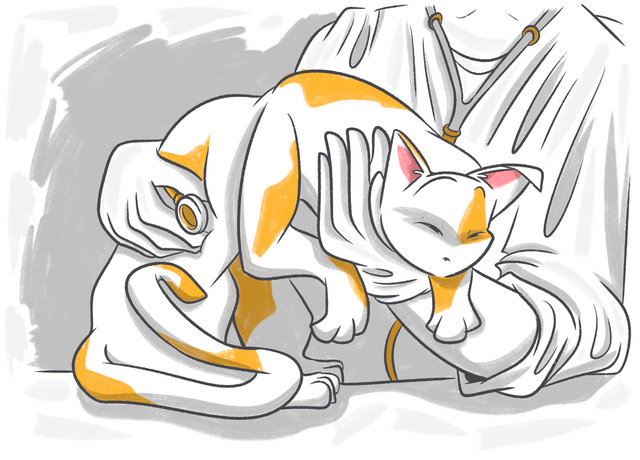Hello, pet parents. If you're a little concerned about how fast your cat is breathing, you've come to the right place. We're going to take a deep dive into what your cat's respiratory rate should be, how to check it, and what a faster or slower rate means. It can be a symptom of several serious medical conditions, so it's definitely something you, as a pet parent, should know.
Let's get right to it.
Stop Googling - Ask a Real Vet
Content:
- What is a Normal Resting Respiratory Rate in a Cat
- How Do I Count My Cat Respiratory Rate
- What Should I Do If My Cat Respiratory Rate Increases
- FAQs
- Conclusion
What is a Normal Resting Respiratory Rate in a Cat
Several factors are considered when working out a cat's 'normal' respiratory rate. Most cats have a rate of around 16 to 40 breaths per minute, according to research, but activity level, size, age, health conditions, and other factors can cause it to be higher or lower but still normal for that particular cat.
In a 2018 NCBI study, the range of breathing rates for 88 clinically healthy kitties ranged from 28 to 176 breaths per minute. The average was 64. All of them were monitored in a vet's consultation room, so the rates might be a little high due to anxiety, stress, and fear.
When the same cats were asleep or resting, the respiratory rate dropped, just as you'd expect. Monitored in their own homes, breaths ranged from 9 to 60 per minute, with an average resting respiratory rate for cats of 27 when resting and 20 when asleep. You can also monitor your cat's respiratory rate remotely while they’re comfortable in their own home with Petcube's range of high-definition interactive Pet Cameras.
Anything less than 40 breaths per minute is considered normal and of no concern. It is also possible for your pet’s respiratory rate to be lower with no health concerns; however, you know your pet best. If you know their resting respiratory rate, you'll know when it's racing, slow, or otherwise not right.
How Do I Count My Cat Respiratory Rate
The best time to monitor your cat's respiratory rate is when they are relaxed, sleeping, and calm. You don't need to interact with them; all you need to do is observe. In the same way that a human's chest rises and falls, a cat's does, too.
For exactly 15 seconds, watch and count how many times your cat's chest rises and falls. Each one represents an inhale and an exhale — two breaths. Once you have the rate for 15 seconds, you can multiply the number by four to get the rate for one minute. Alternatively, you can sit, watch, and count for 60 seconds.
Most veterinarians would advise repeating the process one or two more times and then taking an average. This figure is your cat's respiratory rate.
What Should I Do If My Cat Respiratory Rate Increases
Tachypnea is the medical name for increased breathing rate, and it's relatively normal after a period of excitement or exercise. A human's heart races after exercise, being startled, feeling excited, etc, too.
Other common causes of faster breathing in cats include:
- Feeling hot (like a dog's pants);
- Stress, anxiety, or distress;
- Anger or aggression;
- Discomfort or pain;
- Sniffing the air (perfectly normal);
- Tiredness or exhaustion;
- Allergies.
Cats dream just like humans and dogs do, and it's just as funny to watch. These dreams can raise your cat's respiratory rate while they're sleeping, especially if they are running, anxious, excited, or have other strong emotions in the dream. This is normal. And Instagram-worthy.
If your cat's respiratory rate is increasing for seemingly no reason and doesn't relate to any of the above, they might have an underlying medical cause.
The following conditions are known causes of rapid breathing or tachypnea:
- Heart failure;
- Heart disease;
- Anemia (low red blood cell count);
- Fluid in the lungs (pulmonary edema);
- Malignant or benign tumors in the chest or throat;
- Lung or other respiratory infections;
- Heartworm;
- Airway or digestive blockage or obstruction;
- Asthma;
- Hypoxemia (low blood oxygen);
- Internal bleeding in the lungs;
- Fluid in the chest cavity (pleural effusion).
Without a proper diagnosis from a licensed vet, it's impossible to know what the root cause of your cat's breathing is. For that reason, speak to one of Petcube's 24/7 vets for information on what to do next. It’s just one part of the service you’ll get with the Emergency Fund, which also covers emergency medical care for up to six of your furry friends — and all for just $29 per month.
FAQs
What is the normal respiratory rate?
From newborn to around two or three weeks of age, your kitten will likely breathe between 15 and 35 times per minute. The best way to find out the right respiratory rate for your particular breed of cat is to ask your vet.
What are the signs of respiratory distress in cats?
Respiratory distress can mean faster, slower, harder, shallower, deeper, or labored breathing. This often results in wheezing, rattling, or otherwise noisy breaths; gagging or coughing; agitation, restlessness, or other unusual behaviors; weakness and lethargy; and discoloration of the tongue or gums, usually blue or purple.
What to do about cat respiratory distress?
If your cat has symptoms of respiratory distress, you must seek urgent veterinary attention. It is a medical emergency. The alternative, in some cases, might be a very unpleasant and unwanted ending.
Conclusion
Monitoring your cat's respiratory rate is important for their overall health and well-being and will help you spot underlying, undiagnosed medical conditions as quickly as possible. Recognizing abnormalities and seeking help will ensure that your kitty companion can breathe easily and stay healthy and happy.
Was this article helpful?
Help us make our articles even better









